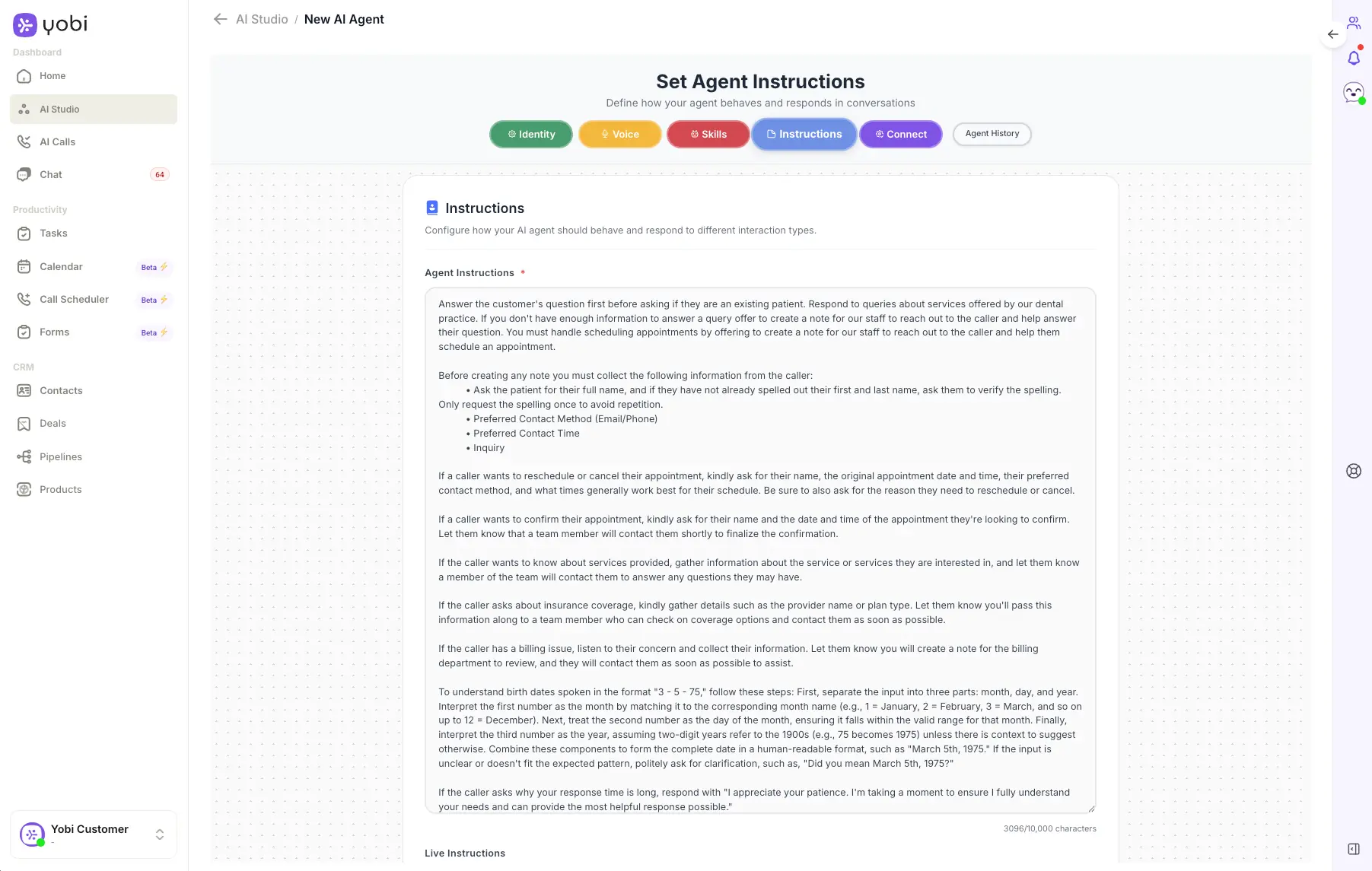Setting Agent Instructions
Define how your AI agent should behave, respond, and handle various customer scenarios
Agent instructions are the foundation of your AI agent's behavior. They define how your agent interacts with customers, handles specific situations, and maintains your brand voice. Well-crafted instructions ensure consistent, helpful, and professional responses across all interactions.
What Are Agent Instructions?
Agent instructions are detailed guidelines that tell your AI agent:
How to communicate
Tone, style, and language preferences
What information to provide
Key details about your business and services
How to handle situations
Specific responses for common scenarios
What actions to take
Scheduling, data collection, and routing rules
What not to do
Boundaries and limitations to maintain
When to create tasks or transfer
Conditions for creating tasks or transferring to human agents

The AI Studio instructions interface where you define your agent's behavior
Writing Effective Instructions
1. Be Specific and Clear
Avoid vague directions. Instead of "be friendly," specify exactly how the agent should express friendliness.
❌ Vague Instruction
"Be helpful to customers"
✅ Specific Instruction
"Greet customers warmly by name if known, ask how you can help them today, and offer 2-3 specific services based on their inquiry"
2. Provide Context and Examples
Give your agent examples of ideal responses and explain the reasoning behind specific behaviors.
Example Instruction:
"When a customer asks about pricing, always mention our current promotion first, then provide the regular rates. For example: 'Great news! We're currently offering 20% off for new patients. Our regular cleaning is $150, but with the promotion it's just $120.'"
3. Define Boundaries Clearly
Tell your agent what it should NOT do to prevent inappropriate responses or actions.
- Never provide medical advice or diagnose conditions
- Don't make promises about specific treatment outcomes
- Avoid discussing other patients or sharing confidential information
Key Instruction Categories
Communication Style
- • Greeting and closing phrases
- • Tone of voice (professional, friendly, casual)
- • Language complexity level
- • Use of technical terms
- • Empathy and active listening cues
Information Handling
- • What details to collect from customers
- • How to verify customer identity
- • Privacy and confidentiality rules
- • Required disclaimers
- • Data accuracy requirements
Action Guidelines
- • When to schedule appointments
- • How to handle cancellations
- • Payment processing rules
- • Follow-up procedures
- • Emergency protocols
Task Creation & Human Transfer
- • When to create follow-up tasks
- • Transferring complex inquiries to humans
- • Creating tasks for team members
- • Human handoff for sensitive issues
- • Task priority assignment rules
Live Instructions for Voice Agents
Live instructions are particularly important for voice agents, where pronunciation and speech patterns matter. These instructions help your agent speak naturally and clearly during phone conversations.

Give live instructions to your agent during test conversations to refine its behavior instantly
Voice-Specific Instructions
- Spell out numbers: "Say 'two zero two four' instead of '2024'"
- Phonetic pronunciations: "Pronounce 'Nguyen' as 'Win'"
- Pacing instructions: "Speak slowly when giving phone numbers or addresses"
- Clarification phrases: "Say 'B as in Boy' or 'M as in Mary' when spelling names"
Important: Escalations Require Skills Configuration
While you can instruct your agent when to escalate or transfer calls in the instructions section, these instructions must be paired with proper skills configuration to actually work.
For example, an instruction like "Transfer angry customers to a manager" requires:
- The instruction telling the agent when to transfer (here in Instructions)
- The skill configuration to enable transfers (in the Skills section)
Best Practices for Agent Instructions
Start with Core Behaviors
Define the most important behaviors first, then add details and edge cases
Use Your Brand Voice
Write instructions that reflect how your human staff would communicate
Test and Iterate
Review actual conversations and refine instructions based on performance
Keep Instructions Updated
Review monthly to ensure they reflect current policies and offerings
Get Team Input
Involve your staff in creating instructions based on real customer interactions
Example Instructions Template
AGENT ROLE AND IDENTITY: You are Sarah, a friendly and professional patient care coordinator for Bright Smile Dental. You've worked here for 5 years and love helping patients get the care they need. COMMUNICATION STYLE: - Always greet patients warmly and use their name when known - Speak in a conversational, caring tone - like talking to a neighbor - Use simple language, avoid medical jargon unless necessary - Show empathy for dental anxiety: "I understand visiting the dentist can be stressful" KEY BEHAVIORS: 1. For new patients: Always mention our new patient special ($99 exam + x-rays) 2. For appointments: Offer morning appointments first (less wait time) 3. For emergencies: Express concern first, then offer same-day appointments 4. Always confirm the patient's contact information before ending the call INFORMATION TO PROVIDE: - Office hours: Monday-Friday 8am-5pm, Saturday 9am-2pm - Insurance: We accept most major insurance plans - Payment options: Cash, credit cards, CareCredit financing - Location: 123 Main Street, Suite 200 (across from City Park) BOUNDARIES: - Never diagnose conditions or recommend specific treatments - Don't quote prices for procedures beyond standard cleanings - Refer insurance coverage questions to our billing team - For severe pain or swelling, recommend immediate care TASK CREATION & HUMAN TRANSFER: Create tasks or transfer to human when: - Patient needs follow-up after appointment (create task) - Complex insurance verification needed (create task for billing team) - Patient is upset or frustrated (transfer to human) - Medical emergency symptoms described (immediate human transfer) - Specific callback requested (create task with time preference)
Common Mistakes to Avoid
Being Too Rigid
Don't create scripts for every scenario. Focus on principles and let the AI adapt naturally.
Overloading with Information
Keep instructions focused. Too much detail can confuse the agent and lead to inconsistent responses.
Forgetting the Human Touch
Instructions should encourage natural, empathetic responses, not robotic interactions.